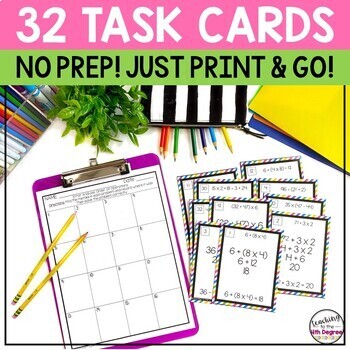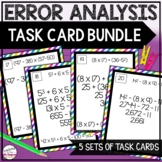Order of Operations Error Analysis Task Cards Print and Digital Activity
- PDF
- Google Apps™

What educators are saying
Also included in
- Help build your students' critical thinking skills with these task cards! This is a bundle of my error analysis task cards. Each set is designed to help students identify common mistakes. This helps them analyze their own work more effectively and improves critical thinking skills.What's IncludedOrdPrice $15.25Original Price $19.70Save $4.45
Description
Want to increase students’ ability to analyze work and identify mistakes? This set of easy to use print or digital task cards will get your students engaged in this process! Students will practice evaluating expressions using the order of operations.
Error analysis activities are a great way for your students to develop critical thinking skills and give them tools to better analyze their own work.
*******CLICK HERE TO SAVE 20% ON THIS PRODUCT BY PURCHASING THE ERROR ANALYSIS BUNDLE!*******
What’s Included
- Set of teacher instructions
- Two sets of 32 task cards (one in color & one in B/W)
- A link to make a copy of this resource to your Google Drive account
- Two types of student response sheets (see note below)
- Answer Key
- Credits/Terms of Use/About the Author
The Task Cards
- Each task card has three equations on it:
- The original equation is at the top
- The equation in the middle is where the student's work is and where the mistake will be shown
- The equation at the bottom is what the student believes the answer is, although it is incorrect.
Student Response Pages
- There are two options for student response sheets:
- Option one includes space specifically for the students to write down what the mistake was, and then another space for them to correct it. I like to use this with my students because it allows them to focus on a few problems and explaining the correct way to solve them.
- Option two is a more traditional answer sheet with numbered boxes for each task card. This works well when you want your students to work on several task cards at once.
The Answer Key
- The correct answer is on the top along with an explanation as to how the incorrect answer was calculated.
Printing
- These task cards come in both color and black & white for your printing convenience.
These task cards are sure to build critical thinking skills with your students and help them realize how easy it is to make a simple mistake (as well as the value of checking their work).
More Error Analysis Practice
Great for individual practice, use in a center, or whole-class review! Let me know how you use them in your classroom.
Click here to follow me! My followers are notified when I post products, which are 50% off for the first 24 hours. This saves you money!
Be sure to leave feedback in order to get products for FREE! This gives you credits that you can use toward other great TPT resources!
Happy Teaching!






